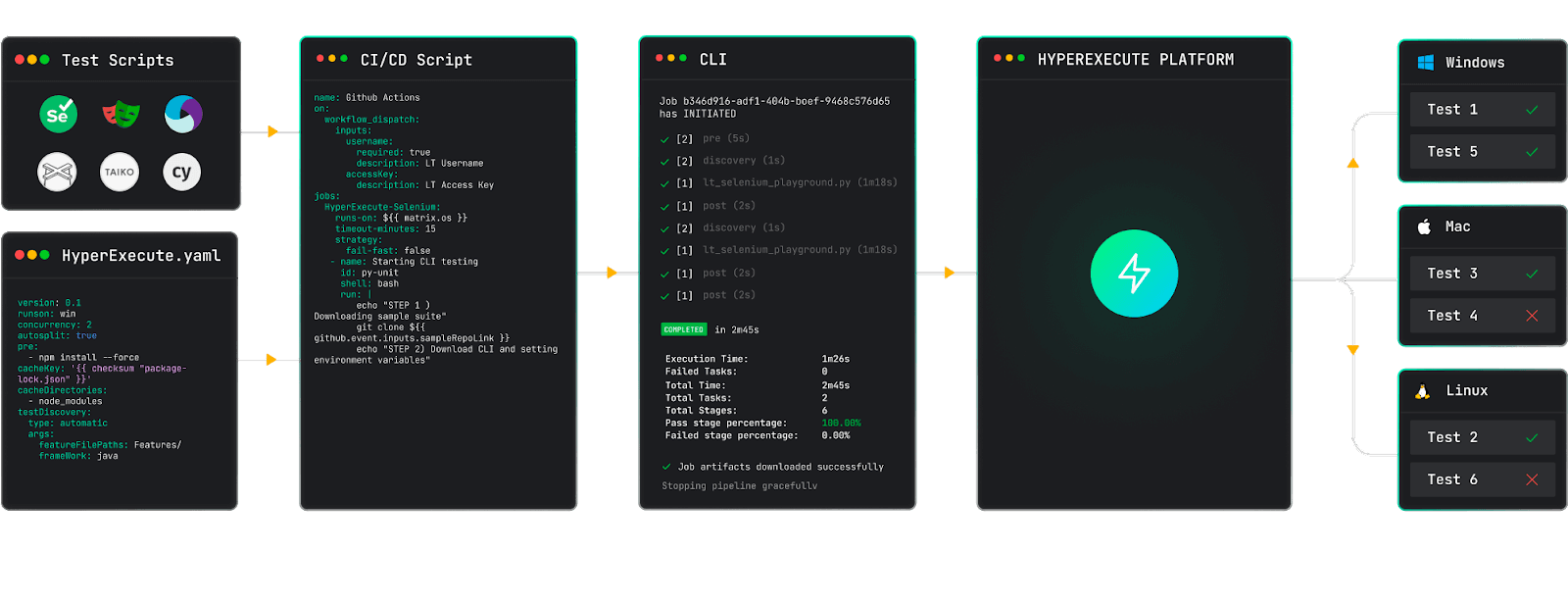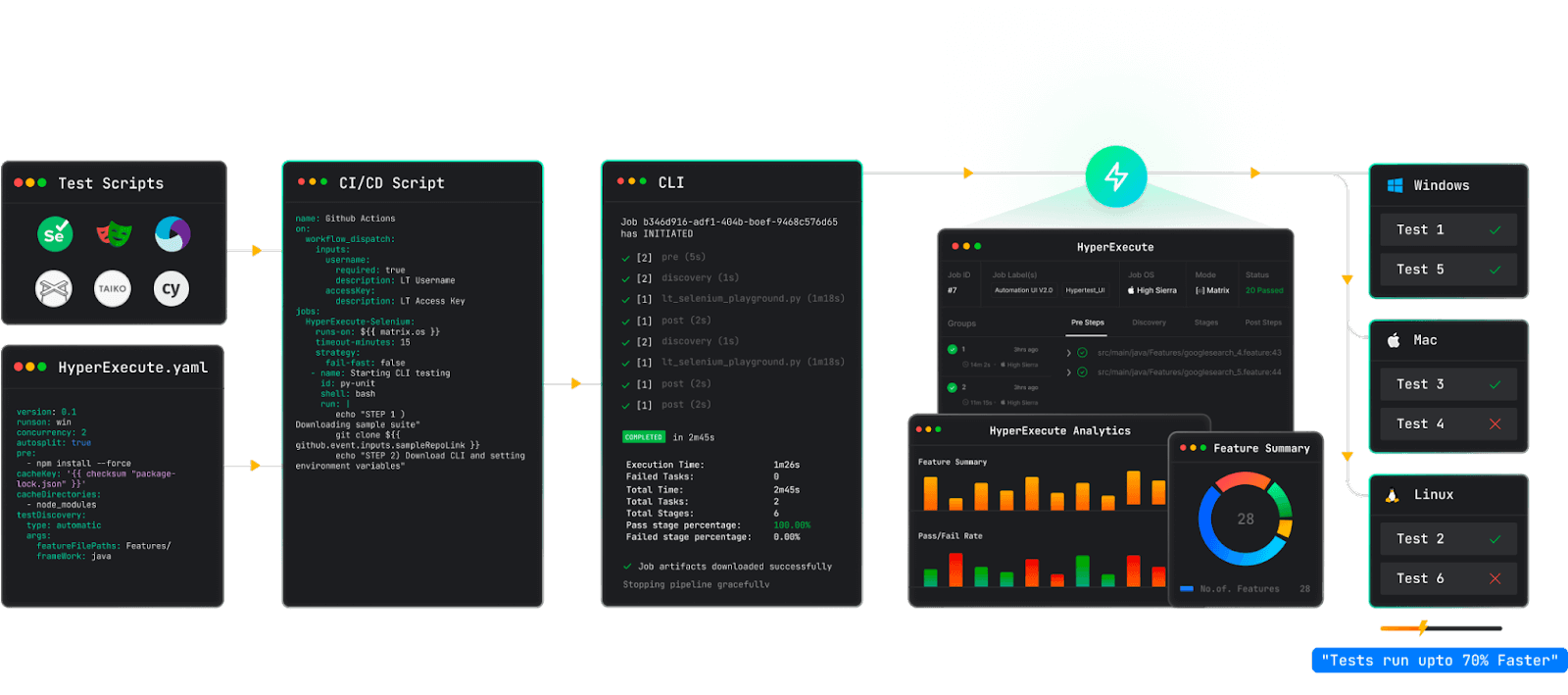Streamlining Testing: Moving from Multi-Tool Chaos to a Unified Environment with CI/CD Integration and Test Analysis
Aman Chopra
Posted On: January 15, 2024
![]() 31056 Views
31056 Views
![]() 6 Min Read
6 Min Read
Every line of code holds a story in the bustling world of software development. In our previous blog, we uncovered the challenges of a growing enterprise grappling with the sluggish pace of test execution and the intricacies of parallelization.
Today, we embark on a new chapter that unfolds at the intersection of Continuous Integration/ Continuous Deployment (CI/CD) tools and test analytics tools.
The Disparate CI/CD Tools and Test Analysis
A noticeable gap emerges as enterprises leverage CI/CD pipelines to trigger and analyze tests. Traditional CI/CD tools typically handle test execution, while separate test analysis platforms handle test results and insights.
This separation creates a siloed approach, where test execution data and analysis are not integrated. Imagine you have triggered the tests and encountered failures, but crucial information about these failures is not easily accessible in subsequent test executions.
This disconnect hampers the efficiency of the testing process and leads to several other challenges:
- Limited Visibility: Analysis Reports lack a holistic view of test performance and are unable to identify trends and patterns that could inform future strategies. This lack of visibility leads to blind spots, redundant testing, and missed opportunities for optimization.
- Delayed Feedback: When test failure information from previous runs is unavailable for the next round of testing, it hinders proactive issue resolution, leading to costly rework and delays in software delivery.
- Inefficient Workflows: QA teams spend precious time manually gathering and analyzing data from multiple sources, diverting their attention from core tasks like test authoring and improving quality.
- Challenges in Scalability: Utilizing traditional CI/CD tools for managing extensive test suites and dispersed teams frequently results in difficulties in scaling, creating obstacles that decelerate the overall development process.
- Disjointed Collaboration: Teams lack a way to share results, insights, and best practices, hindering collaboration and knowledge sharing.
Enhancing Testing Efficiency Through a Unified Platform
Now-a-days, enterprises need to have lots of tools and configurations in their testing process. This sometimes poses a challenge for seamless connectivity while testing and deploying the application components.
In such a situation, having a unified test execution platform that comprehensively addresses the complexities of managing intricate and multifaceted test environments is a boon for the enterprises.
Ensuring Security and Compliance
A unified test execution environment establishes a strong foundation for securing test environments. This significantly reduces the risk of sensitive data breach and ensures compliance with regulations.
Notably, the unified test environment incorporates features such as automated test data protection, concealing private information like credit card details while ensuring secure access to test data in the cloud—an invaluable asset for companies operating in heavily regulated industries.
Real-Time Insights for Quality Improvement
A unified test execution environment provides real-time insights into their testing procedures. This allows QA’s to monitor test progress, identify bottlenecks, and promptly address issues.
This proactive approach assists businesses in detecting and resolving problems before they impact clients, contributing to the delivery of higher-quality software and increased client satisfaction.
Automating the Testing at Scale
Having a unified testing platform facilitates automation at scale. It is very challenging to manage, orchestrate, and analyze numerous test cases across different contexts and systems.
The centralized platform for test case creation, management, and analysis streamlines this complexity, empowering businesses to expand their automation efforts.
According to a report by AIMultiple, in 2022, automation played a pivotal role, with 73% of testers utilizing automated testing or scripting for functional and regression testing, and 45% employing it for unit testing.
LambdaTest Unified Approach to CI/CD and Test Analysis
LambdaTest provides a unified approach. LambdaTest’s HyperExecute emerges as a transformative solution, bridging the gap between CI/CD tools and test analysis by providing a unified platform for both test execution and analysis unlike traditional setups, where different tools handle different aspects.

This unified approach offers several benefits:
- Comprehensive Test Analysis: HyperExecute not only triggers tests but also offers robust test analysis insights from previous test runs, including failures, that are readily available for analysis.
- Single Platform for CI/CD and Analysis: HyperExecute’s cohesive approach eliminates silos that impede communication, seamlessly bridging the gap between CI/CD and analysis. Information flows seamlessly, fostering enhanced efficiency and collaboration across the development lifecycle.
- Multi-Team Collaboration: HyperExecute is designed to accommodate multiple teams seamlessly. Each team can leverage the platform independently, yet the unified nature ensures collaboration and shared insights.
- Test Orchestration: The distributed nature of HyperExecute extends beyond test execution. Teams can efficiently manage distributed test cases, optimizing resources and ensuring faster execution times.
What Features Does HyperExecute Provide?
Navigating actionable insights from test runs in complex or large test builds/systems has long been a challenging endeavor. QA teams encounter difficulties in efficiently monitoring and identifying issues. In response to these challenges, HyperExecute presents a suite of features designed to streamline and enhance the testing process.
Let’s delve into these powerful functionalities:
- FailFast – Rapid Identification of Issues: HyperExecute introduces a fail-fast mechanism, promptly identifying the issue and stopping the test execution further. This accelerates the feedback loop, enabling teams to address problems swiftly.
- AutoHeal – Identify and Heal the Flaky Tests: HyperExecute’s Auto Healing feature helps you enhance the robustness of the test suites by automatically overcoming the flaky tests that cause unexpected failures during the execution of your test scripts.
- Mute Unwanted Tests: The Test Muting feature allows you to temporarily disable a test case from being executed. It is useful for skipping failing or irrelevant tests, which can improve the efficiency and effectiveness of your test runs and help you focus on the most important results.
- AI-Powered Root Cause Analysis: The AI-powered Root Cause Analysis (RCA) and Error Detection provides a thorough overview of the underlying causes of various error categories and aid in the rapid identification of these categories. It examines your test logs to find the main reason for errors so you can promptly and effectively fix the problem.

Conclusion
In the dynamic world of software development, where speed and quality are paramount, efficient and insightful testing plays a pivotal role. Through its structure, HyperExecute eliminates the issues caused by providing a single platform for both CI/CD and analysis, it empowers enterprises to gain comprehensive insights and identify trends that inform future strategies.This unified approach transforms the testing landscape, propelling enterprises into a future where efficiency and collaboration intertwine seamlessly, leading to faster software delivery and a significant competitive advantage.
Got Questions? Drop them on LambdaTest Community. Visit now
















